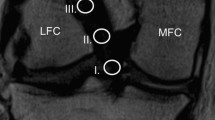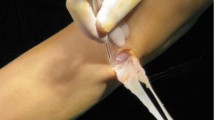Abstract
Purpose
To assess the MRI-measured structural integrity of hamstring autograft at 9 months after anterior cruciate ligament reconstruction (ACLR) surgery.
Methods
A prospective cohort study was conducted including 34 patients (mean age 36.8 ± 11.8 years; 73.5% males) who underwent ACLR with hamstring autograft. In addition, 36 patients (mean age 39.2 ± 10.5 years; 69.4% males) without any ACL injury were also reviewed and served as control group. The primary outcome used for examining graft maturity at 9 months after ACLR was the MRI-based signal-to-noise quotient (SNQ) of reconstructed ACL. SNQ values were stratified into 3 different categories: excellent: < 0.1; good: ≥ 0.1 and ≤ 0.19; fair: ≥ 0.2. The KT-1000 knee arthrometer was used to measure the side-to-side difference in the anterior tibial translation between the ACLR knee and the contralateral healthy knee in the ACLR group.
Results
Reconstructed ACLs were found with a mean SNQ of 0.078 ± 0.061, while almost all ACL-reconstructed patients (97%; 33 out of 34) were found with excellent or good SNQ values (< 0.019). The mean KT-1000 in the ACLR group was 0.071 mm ± 0.926 mm, while there were no patients in the ACLR cohort with a KT-1000 value > 3 mm. The mean 9-months MRI-based SNQ of ACLR group was significantly higher compared to the mean MRI-based SNQ of the control group (p < 0.001). Multiple regression analysis showed no correlation between SNQ and age, gender, time from injury to ACLR, graft size, or simultaneous treatment of additional intra-articular knee lesions.
Conclusions
In this cohort of 34 ACL-reconstructed patients, 97% of hamstring tendon autografts demonstrated excellent/good MRI signal intensity and excellent functional results (KT-1000 < 3 mm) at 9 months after surgery. Based on this finding, it is suggested that return to sports after ACLR with hamstring autograft can be considered safe at 9 months post surgery. Furthermore, while structural integrity of the graft has been achieved at this time point, statistical differences found in SNQ values of ACL-reconstructed patients compared to ACLs of healthy individuals highlight the continuing process of graft maturation and remodelling.
Level of evidence
Level III.



Similar content being viewed by others
Abbreviations
- RTS:
-
Return to sport
- ACLR:
-
Anterior cruciate ligament reconstruction
- ACL:
-
Anterior cruciate ligament
- SNQ:
-
Signal-to-noise quotient
- BPTB:
-
Bone–patellar–tendon–bone
- ROM:
-
Range of motion
- ROI:
-
Region of interest
References
Arnold MP, Calcei JG, Vogel N, Magnussen RA, Clatworthy M, Spalding T, Campbell JD, Bergfeld JA, Sherman SL, ACL Study Group (2021) ACL Study Group survey reveals the evolution of anterior cruciate ligament reconstruction graft choice over the past three decades. Knee Surg Sports Traumatol Arthrosc 29:3871–3876. https://doi.org/10.1007/s00167-021-06443-9
Barber-Westin SD, Noyes FR (2011) Factors used to determine return to unrestricted sports activities after anterior cruciate ligament reconstruction. Arthroscopy 27:1697–1705
Beischer S, Hamrin Senorski E, Thomeé C, Samuelsson K, Thomeé R (2018) Young athletes return too early to knee-strenuous sport, without acceptable knee function after anterior cruciate ligament reconstruction. Knee Surg Sports Traumatol Arthrosc 26:1966–1974
Biercevicz AM, Miranda DL, Machan JT, Murray MM, Fleming BC (2013) In Situ, noninvasive, T2*-weighted MRI-derived parameters predict ex vivo structural properties of an anterior cruciate ligament reconstruction or bioenhanced primary repair in a porcine model. Am J Sports Med 41:560–566
Bouguennec N, Robinson J, Douiri A, Graveleau N, Colombet PD (2021) Two-year postoperative MRI appearances of anterior cruciate ligament hamstrings autografts are not correlated with functional outcomes, anterior laxity, or patient age. Bone Joint Open 2:569–575
Chu CR, Williams AA (2019) Quantitative MRI UTE-T2* and T2* Show Progressive and Continued Graft Maturation Over 2 Years in Human Patients After Anterior Cruciate Ligament Reconstruction. Orthop J Sports Med 7:2325967119863056
De Fazio MW, Curry EJ, Gustin MJ, Sing DC, Abdul-Rassoul H, Ma R, Fu F, Li X (2020) Return to sport after ACL reconstruction with a BTB versus hamstring tendon autograft: a systematic review and meta-analysis. Orthop J Sports Med 8:2325967120964919
van Eck CF, Schkrohowsky JG, Working ZM, Irrgang JJ, Fu FH (2012) Prospective analysis of failure rate and predictors of failure after anatomic anterior cruciate ligament reconstruction with allograft. Am J Sports Med 40:800–807
Ekdahl M, Wang JH-C, Ronga M, Fu FH (2008) Graft healing in anterior cruciate ligament reconstruction. Knee Surg Sports Traumatol Arthrosc 16:935–947
Faleide AGH, Magnussen LH, Strand T, Bogen BE, Moe-Nilssen R, Mo IF, Vervaat W, Inderhaug E (2021) The role of psychological readiness in return to sport assessment after anterior cruciate ligament reconstruction. Am J Sports Med 49:1236–1243
Grassi A, Kim C, MarcheggianiMuccioli GM, Zaffagnini S, Amendola A (2017) What is the mid-term failure rate of revision ACL reconstruction? A systematic review. Clin Orthop 475:2484–2499
Grindem H, Snyder-Mackler L, Moksnes H, Engebretsen L, Risberg MA (2016) Simple decision rules reduce reinjury risk after anterior cruciate ligament reconstruction. Br J Sports Med 50:804–808
Harris JD, Abrams GD, Bach BR, Williams D, Heidloff D, Bush-Joseph CA, Verma NN, Forsythe B, Cole BJ (2014) Return to sport after ACL reconstruction. Orthopedics 37:e103-108
Hofbauer M, Soldati F, Szomolanyi P, Trattnig S, Bartolucci F, Fu F, Denti M (2019) Hamstring tendon autografts do not show complete graft maturity 6 months postoperatively after anterior cruciate ligament reconstruction. Knee Surg Sports Traumatol Arthrosc 27:130–136
Janssen RPA, van der Wijk J, Fiedler A, Schmidt T, Sala HAGM, Scheffler SU (2011) Remodelling of human hamstring autografts after anterior cruciate ligament reconstruction. Knee Surg Sports Traumatol Arthrosc 19:1299–1306
Kaplan Y, Witvrouw E (2019) When is it safe to return to sport after ACL reconstruction? Reviewing the criteria. Sports Health 11:301–305
Kyritsis P, Bahr R, Landreau P, Miladi R, Witvrouw E (2016) Likelihood of ACL graft rupture: not meeting six clinical discharge criteria before return to sport is associated with a four times greater risk of rupture. Br J Sports Med 50:946–951
Lai CCH, Ardern CL, Feller JA, Webster KE (2018) Eighty-three per cent of elite athletes return to preinjury sport after anterior cruciate ligament reconstruction: a systematic review with meta-analysis of return to sport rates, graft rupture rates and performance outcomes. Br J Sports Med 52:128–138
Li H, Chen S, Tao H, Li H, Chen S (2014) Correlation analysis of potential factors influencing graft maturity after anterior cruciate ligament reconstruction. Orthop J Sports Med 2:2325967114553552
Losciale JM, Zdeb RM, Ledbetter L, Reiman MP, Sell TC (2019) The association between passing return-to-sport criteria and second anterior cruciate ligament injury risk: a systematic review with meta-analysis. J Orthop Sports Phys Ther 49:43–54
Ma Y, Murawski CD, Rahnemai-Azar AA, Maldjian C, Lynch AD, Fu FH (2015) Graft maturity of the reconstructed anterior cruciate ligament 6 months postoperatively: a magnetic resonance imaging evaluation of quadriceps tendon with bone block and hamstring tendon autografts. Knee Surg Sports Traumatol Arthrosc 23:661–668
Meredith SJ, Rauer T, Chmielewski TL, Fink C, Diermeier T, Rothrauff BB, Svantesson E, HamrinSenorski E, Hewett TE, Sherman SL, Lesniak BP, Panther Symposium ACL Injury Return to Sport Consensus Group (2020) Return to sport after anterior cruciate ligament injury: panther symposium ACL injury return to sport consensus group. Knee Surg Sports Traumatol Arthrosc 28:2403–2414
Nagelli CV, Hewett TE (2017) Should return to sport be delayed until two years after anterior cruciate ligament reconstruction? Biological and functional considerations. Sports Med Auckl NZ 47:221–232
Paterno MV, Rauh MJ, Schmitt LC, Ford KR, Hewett TE (2014) Incidence of second ACL injuries 2 years after primary ACL reconstruction and return to sport. Am J Sports Med 42:1567–1573
Pouderoux T, Muller B, Robert H (2020) Joint laxity and graft compliance increase during the first year following ACL reconstruction with short hamstring tendon grafts. Knee Surg Sports Traumatol Arthrosc 28:1979–1988
Scheffler SU, Unterhauser FN, Weiler A (2008) Graft remodeling and ligamentization after cruciate ligament reconstruction. Knee Surg Sports Traumatol Arthrosc 16:834–842
Uchio Y, Ochi M, Adachi N, Kawasaki K, Kuriwaka M (2003) Determination of time of biologic fixation after anterior cruciate ligament reconstruction with hamstring tendons. Am J Sports Med 31:345–352
Webster KE, Feller JA (2020) Who passes return-to-sport tests, and which tests are most strongly associated with return to play after anterior cruciate ligament reconstruction? Orthop J Sports Med 8:2325967120969425
Webster KE, Hewett TE (2019) What is the evidence for and validity of return-to-sport testing after anterior cruciate ligament reconstruction surgery? A systematic review and meta-analysis. Sports Med Auckl NZ 49:917–929
Weiler A, Peters G, Mäurer J, Unterhauser FN, Südkamp NP (2001) Biomechanical properties and vascularity of an anterior cruciate ligament graft can be predicted by contrast-enhanced magnetic resonance imaging. A two-year study in sheep. Am J Sports Med 29:751–761
Wiggins AJ, Grandhi RK, Schneider DK, Stanfield D, Webster KE, Myer GD (2016) Risk of secondary injury in younger athletes after anterior cruciate ligament reconstruction: a systematic review and meta-analysis. Am J Sports Med 44:1861–1876
Zaffagnini S, Grassi A, Serra M, Marcacci M (2015) Return to sport after ACL reconstruction: how, when and why? A narrative review of current evidence. Joints 3:25–30
Funding
The authors declare that they have had no funding source for doing this research work.
Author information
Authors and Affiliations
Contributions
MM wrote the manuscript, participated in the conception and design of the study and in the interpretation of data and participated in the ACL reconstructions. FC critically revised and edited the manuscript, participated in the acquisition of data, and assisted during the operations. CB analyzed MRI images participated in the acquisition of data and critically revised the manuscript. MV participated in the conception and design of the study. MM and LG statistically analyzed the data and critically revised and edited the manuscript. MH and DT conceived the study and participated in its design. MD conceived the study and participated in its design and coordination, carried out all the operations and had the final checking of the manuscript. All authors read and approved the final manuscript.
Corresponding author
Ethics declarations
Conflict of interest
MM, FC, CB, MM, LG, MH, DT, MD declare that they have no competing interests. MV is a paid consultant of Lipogem SpA.
Ethical approval
Institutional review board approval for the study was provided by the Medical University of Vienna (no. 1562–2014).
Additional information
Publisher's Note
Springer Nature remains neutral with regard to jurisdictional claims in published maps and institutional affiliations.
Rights and permissions
About this article
Cite this article
Malahias, MA., Capece, F.M., Ballarati, C. et al. Sufficient MRI graft structural integrity at 9 months after anterior cruciate ligament reconstruction with hamstring tendon autograft. Knee Surg Sports Traumatol Arthrosc 30, 1893–1900 (2022). https://doi.org/10.1007/s00167-021-06830-2
Received:
Accepted:
Published:
Issue Date:
DOI: https://doi.org/10.1007/s00167-021-06830-2




